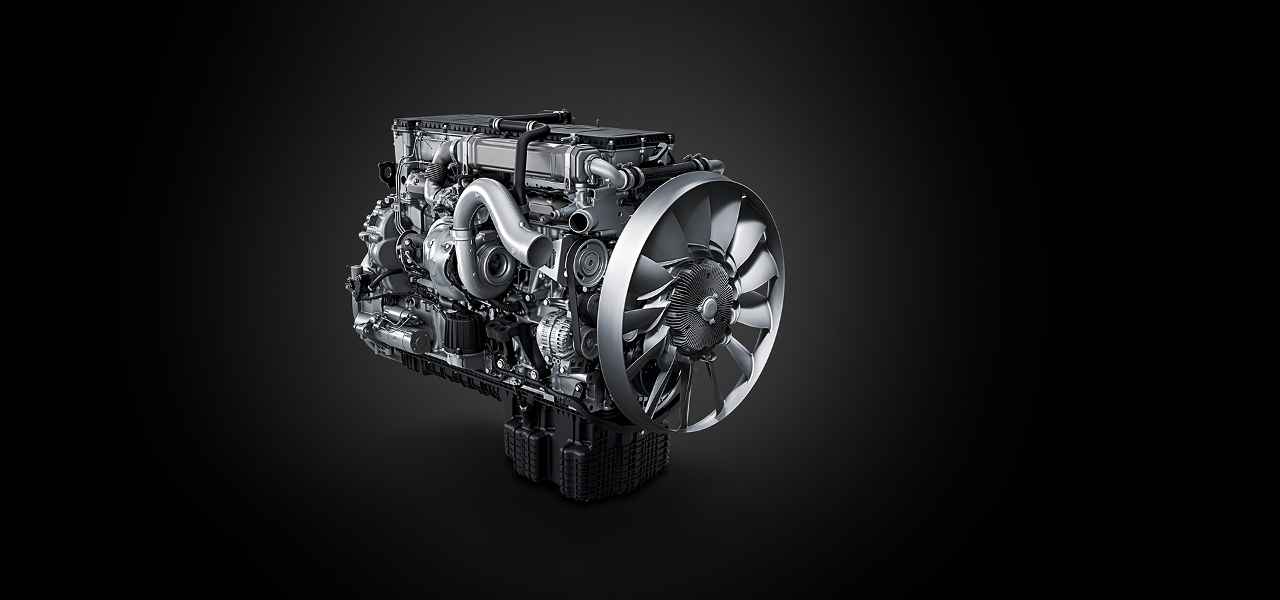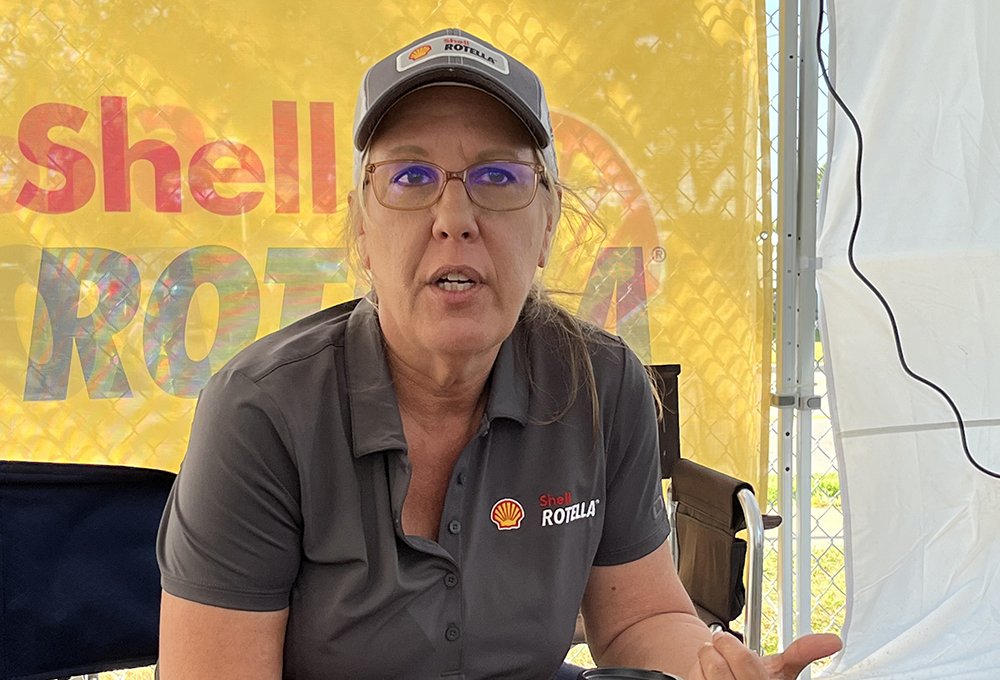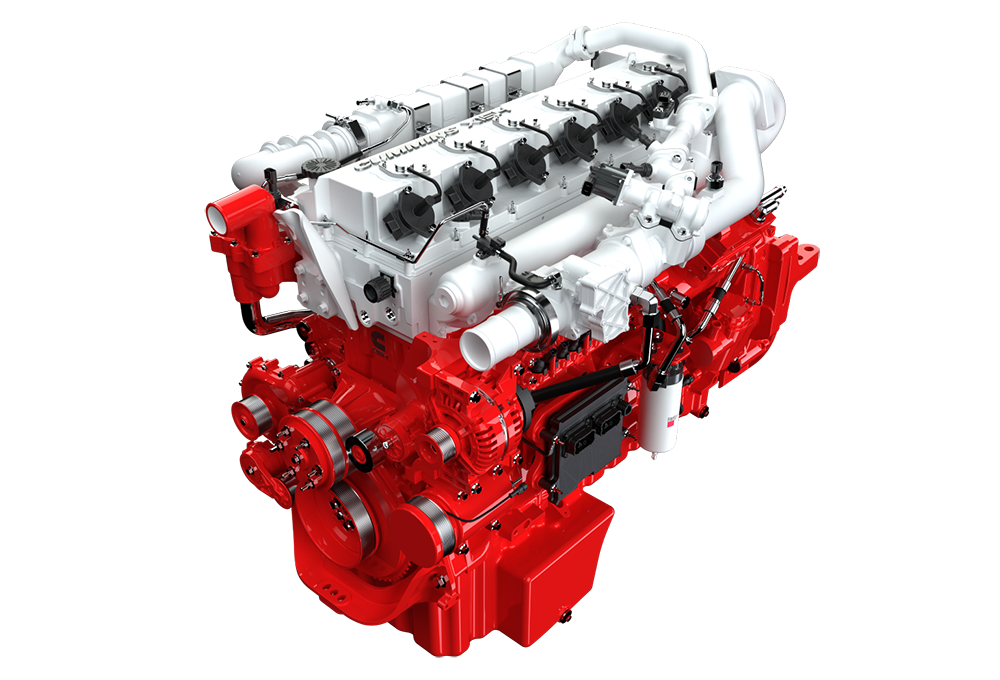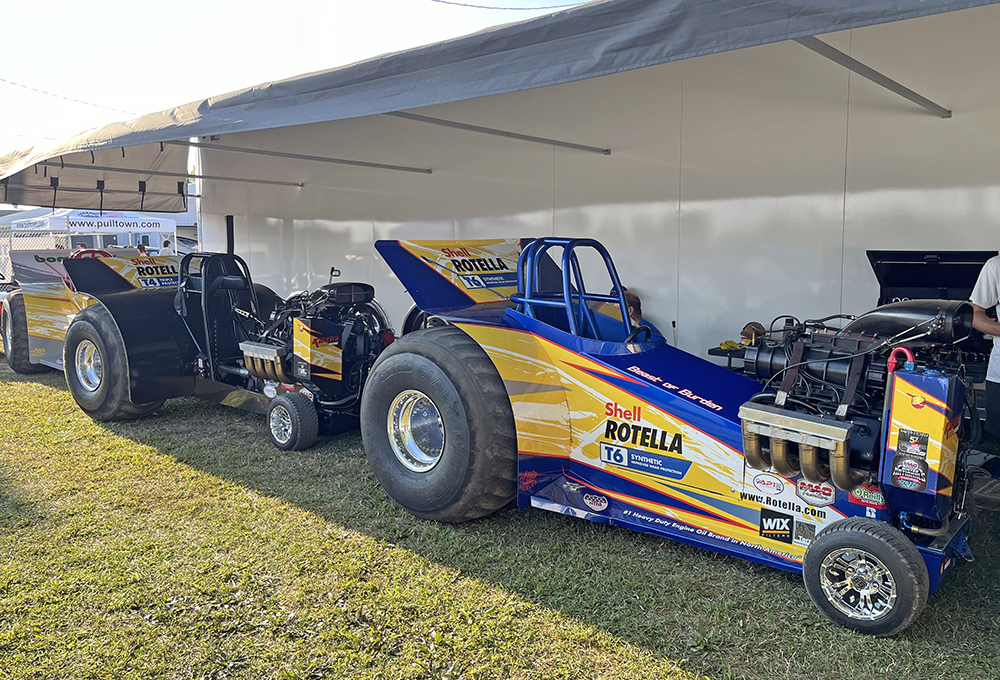 低粘度xW20发动机机油已在欧洲开展应用。如图所示,梅赛德斯-奔驰卡车第三代OM 471发动机采用的“全新研发的低粘度发动机机油”不仅能改善油压控制,还能提升燃油效率。(梅赛德斯)
低粘度xW20发动机机油已在欧洲开展应用。如图所示,梅赛德斯-奔驰卡车第三代OM 471发动机采用的“全新研发的低粘度发动机机油”不仅能改善油压控制,还能提升燃油效率。(梅赛德斯) 壳牌全球解决方案 OEM 技术经理 Karin Haumann 在俄亥俄州鲍灵格林举行的全国拖拉机拉力锦标赛上。(SAE/Ryan Gehm)
壳牌全球解决方案 OEM 技术经理 Karin Haumann 在俄亥俄州鲍灵格林举行的全国拖拉机拉力锦标赛上。(SAE/Ryan Gehm) 壳牌与氢燃料发动机(如图中的康明斯 X15H)等新开发产品的制造商密切合作,提供候选机油、支持动力测试并评估其他需求。(康明斯)
壳牌与氢燃料发动机(如图中的康明斯 X15H)等新开发产品的制造商密切合作,提供候选机油、支持动力测试并评估其他需求。(康明斯) Koester Racing的壳牌Rotella赞助的拖拉机使用基于核心化学成分的发动机机油,但 “在这里和那里做了一些调整”。(SAE/Ryan Gehm)
Koester Racing的壳牌Rotella赞助的拖拉机使用基于核心化学成分的发动机机油,但 “在这里和那里做了一些调整”。(SAE/Ryan Gehm) 拖拉机牵引与测功机测试类似,都是对自然现象的加速,对壳牌的研发工作很有价值。(SAE/Ryan Gehm)
拖拉机牵引与测功机测试类似,都是对自然现象的加速,对壳牌的研发工作很有价值。(SAE/Ryan Gehm)
壳牌全球解决方案的Karin Haumann在采访中分享了关于新型PC-12发动机机油的见解,并探讨了替代燃料对其研发过程的影响。
Karin:壳牌会一如既往地全力支持OEM的发动机研发,并与其共同开发与发动机配套的机油。发动机制造商开始研发新机型时,通常会在现有机油的基础上开展工作。目前,他们仍在确定新机油将面临的挑战或特殊需求。因此,我们会与OEM保持密切协作,为他们提供不同的候选机油,并借助现有产品支持他们开展测功机测试,同时评估是否需要提供额外的技术支持。不过,这些新项目短期内不会影响行业标准。但不论何时,我们都会尽全力支持OEM,协助他们推进产品研发。
Karin:对于壳牌的特定产品,美国休斯敦的技术中心主要负责PC-12机油的研发,而德国汉堡的技术中心则专注欧洲市场的机油研发。两个技术中心密切合作,致力于寻找可以互补的研发领域。我们的欧洲同事与我们保持紧密联系,因为我想了解欧洲市场OEM的具体需求、面临的问题以及需要改进的地方。这样一来,我们也会在PC-12的研发中尽力满足这些需求。
Karin:我不确定我们是否会为Koester Racing的应用专门开发升级版机油。显然Koester会有一些特殊需求,这通常是由壳牌赛车部门负责的独立项目。但与Koester的合作对我们来说也非常重要,因为这涉及到对机油性能的终极压力测试。尽管使用的配方可能略有不同,但都是基于我们在Rotella系列中使用的核心化学配方,只是在某些方面进行了调整,以满足他们的特定需求。通过与Koester合作,我们能获得他们对机油性能的反馈,这对我们来说极为宝贵。就像测功机测试一样,其本质是将跑10万英里的自然过程加速,并在200小时内完成。这种比赛也类似,它完美展现了我们可以做到这一点,因此对我们来说始终具有重要价值。
Q&A with Karin Haumann of Shell Global Solutions offers insights into new PC-12 oils and how alternative fuels impact the development process.
Shell Rotella hosted journalists at the National Tractor Pulling Championships in Bowling Green, Ohio, in August, where the company was sponsoring tractors run by Koester Racing in the mini-modified division. Karin Haumann, OEM technical manager of Shell Global Solutions, was onsite and spoke with SAE Media about the approaching proposed category 12 (PC-12) heavy-duty diesel engine oil category. PC-12 engine oils are in development and will be licensed for use on January 1, 2027. The current engine oil categories, CK-4 and FA-4, were introduced in 2016.
Development of the new category is necessary due to advancements in engine technology, and it aligns with stricter emissions regulations that begin in 2027, said Haumann, who serves as chairperson of the API new category development team. “As diesel engine technology evolves, they require oils that offer increased oxidation performance and wear reduction, can handle higher temperatures, and improve fuel economy,” she said. Lubricant producers also must meet reduced phosphorous and sulfated ash limits, which otherwise can compromise emission control systems and negatively impact fuel economy.
Where does PC-12 stand in the development process?
The category is pretty much developed with respect to what the new requirements are, what the performance requirements are. We’re going through testing of the engine dyno tests to get the precision and the repeatability and all of that for the new tests and base oil interchange and read across guidelines, that stuff. In the next year, part of the API process is we have a 12-month tech demonstration period, where the oil marketers will have a year to run the tests and get performance feedback. That all feeds into what the limits are going to be. And then API has a mandatory wait requirement for a year to allow all the companies to have access to the tests. So, we’re about two years away. We’re working on getting candidate oils in field trials and those types of things.
Under PC-12, how do the current FA-4 oils fit into it?
We split the category up into two: PC-12a [for backwards compatibility] and PC-12b, which is the one representing FA-4, because we have slightly different requirements. We’re reducing the soot handling requirement in PC-12b because it’s only for use in modern engines that don’t create 5-6% soot anymore. We’re adding xW20 oils, so we could theoretically license a 5W20 or a 0W20 under the new [designation], presumably it’ll be called FB-4, but we’ll finalize that at the end. But let’s just say FB-4, it’s going to mirror FA-4 with the additional lower viscosities. I don’t expect to see those in the [North American] market anytime soon. We’re future proofing since this category is expected to last through 2040. The OEMs may need that in the future, and we won’t have to develop another category for it.
The 0W20 and 5W20 oils are in Europe now. How does that impact North America?
They are and that’s why we’re introducing those now. You’ve got DTNA and Daimler, Navistar’s now part of Traton, so those companies are working in the two markets whose engine-oil needs have evolved differently over the decades. But they’re trying to gain efficiency by validating one oil across both markets. And they’re trying to develop engines that will work in both markets. So, we’re trying to help them by getting closer to an oil that can be used in both markets. There are still some challenges because the requirements are different, and you don’t want to over-formulate for everybody. That can be counterproductive. But we do see the OEMs now wanting to factory fill with those lower [viscosity] 5W30 FA-4s and even a 5W20 FA-4 in the future. So, we’re trying to support that.
Hydrogen combustion engines are gaining some momentum. How does that factor into what you’re doing?
Shell supports the OEMs and every opportunity that we have to work with them in their engine development and kind of co-develop the oil with the engine. Typically, when an engine manufacturer starts a new development, they will try to start the development on an existing oil that they have. They’re still working on identifying what the stressors are on the oil or what the special needs might be, so we’re working closely, supplying different candidates, supporting their dyno testing with products that we have, and evaluating where there may be some additional needs. That’s not going to trickle into the industry specification for quite some time. But we are working wherever we can with the OEMs to support them with products during their development.
Are renewable fuels considered under PC-12?
Prior to the PC-12 process or the development process, we start with what we call the NCET, new category evaluation team, and then it transitions into new category development team (NCDT). During the evaluation is when we’re working with the OEMs and saying, ‘What do you want? What do you need? What don’t you need? What are the performance targets? And is there a justification for incrementing the category?’ Part of that NCET process, we looked at renewable fuels and how we evaluate for performance. As a group, we just didn’t have enough traction technically to say this is what we should be looking at. So, we decided that was not going to be part of PC-12.
The way the engine manufacturers handle this and the way the API documentation reads is that if you’re using an alternative fuel, consult your OEM. And the way OEMs have been handling it is they just recommend a shorter oil drain interval. A lot of it is kind of engine specific, how is their engine hardware exactly going to be handling what types of fuel? And so it’s a little more specialized, like transmission fluids are. So, that’s how they are going to continue to handle it until we really identify some key features: ‘Oh hey, we need to be watching for and testing for this, and this is how we’re going to do it.’ We’re just not there yet at the industry level.
How do you expect the industry to respond come January 2027?
I wish I could say that it was easy. The problem with the [slower] take rate on FA-4 is so many fleets and organizations have a mixed fleet, mixed applications, and they kind of gravitate to the least common denominator. What’s the one oil that I know can lubricate everything? If they’ve got off-highway equipment or older trucks in their fleet that can’t use FA-4, well they know the FA-4 engine can use CK-4, so let’s just use CK-4 in everything. I will say that the OEMs are working with their fleet customers, expressing the benefits of using it. To be honest, there’s a certain type of fleet that can use it because everything they have is modern. Everything they have is on-highway, all of their trucks are less than five years old. Those kinds of fleets can very easily adopt it. What’s contributed to the increase in FA-4 adoption now is just time, education, people learning about it, fleet turning over. But as you know, in this industry, some of these engines that are on the road are not new.
Where is the development work taking place for Shell?
For our specific products, our main technology center in Houston is in charge of the PC-12 development. We have a technology center also in Hamburg [Germany] that focuses on the development for the European oils. We work very closely together because we’re trying to identify areas where we can overlap. My counterparts in Europe are very tied into what we’re doing … because I want to hear, what are the OEMs over there asking for specifically? What problems are they having? What improvements do they need? So, we try to incorporate as much of that into the PC-12 that we can.
How does motorsports or tractor pulling, for example, tie into Shell’s development?
I don’t know if we’ll be working on a specialized upgrade for [Koester Racing’s] application. That’s a separate thing [handled mostly by Shell’s motorsports unit] because they’ve got some unique needs obviously. But what we do with Koester is important because this is the ultimate stress test on the oil. Their formulation might be slightly different, but it’s based on a core chemistry that we use in Rotella – might have a little tweak here and there for something extra they need. We’re able to get feedback from Koester on how they see the performance. That really does help us. Just like the dyno tests, the purpose is to accelerate a natural phenomenon that takes a hundred thousand miles, but we want to do it in 200 hours. This is similar, it’s a perfect example of how we can do that. So, that’s always valuable for us.
等级
打分
- 2分
- 4分
- 6分
- 8分
- 10分
平均分
- 作者:Ryan Gehm
- 行业:汽车
- 主题:燃料和能源管理与产品开发质量、可靠性与耐久性车辆与性能
